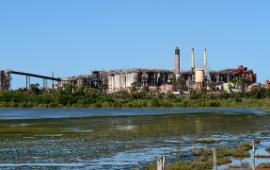Biggest emitters opt to ‘wait and see’ over Emissions Reduction Fund

In Summary
Analysis for The Conversation by Dr Jayanthi Kumarasiri, Lecturer, Swinburne University of Technology and Professor Nava Subramaniam, RMIT University.
Many of Australia’s most carbon-intensive companies are either not participating in the federal government’s flagship Emissions Reduction Fund (ERF), or are adopting a wait-and-see approach, according to our survey of senior executives. ![]()
The ERF, introduced in 2014 after the repeal of the carbon tax, is the central component in the government’s policy to reduce greenhouse emissions. Companies can bid for money from an overall fund of A$2.55 billion, to invest in low-carbon technologies and initiatives. Participation is voluntary.
Five ERF auctions have been held, awarding A$2.23 billion so far. However, participation by high-emitting companies has been persistently low.
Some of the funded projects are likely to deliver useful emissions cuts in areas such as forestry, landfill and waste management. But the scheme is yet to reduce emissions reductions in key sectors of the economy such as industry and electricity generation. Our survey underlines concerns that the scheme is not attracting the biggest emitters.
Asking the questions
Our research, titled the Australian Emission Reduction Fund Survey and produced in collaboration with the Carbon Market Institute, was conducted in two rounds.
First, in 2015, we surveyed executives from high-emitting companies in sectors including mining, manufacturing, energy and transport. Then, in 2016, we surveyed executives from firms that had successfully registered carbon-reduction projects under the ERF. Survey respondents represented a broad range of positions, including managing directors, general managers, senior carbon advisers, heads of environmental markets and strategy, and chief executives.
The first-round survey, which was conducted before the first ERF auction and featured 68 participants, showed that 58% of companies planned to “wait and see” before engaging with the ERF. Another 34% said they did not intend to participate in the scheme at all.
One of the main reasons given for non-participation was the fact that the scheme is run as a reverse auction with no guarantee that bids will be successful. This makes it difficult to invest with certainty in the staffing and administration costs of running carbon-reduction projects. One participant told us:
…administrative costs do not make the ERF cost-effective for the scale of abatement opportunities available.
Respondents also told us that there was a lack of guidance on how to understand and participate in the ERF, and uncertainty over the rules of the safeguard mechanism that is meant to help drive demand for carbon credits.
Another issue that most participants highlighted is the inability to make a business case internally and to secure a relatively high price for emissions reductions. One manager emphasised:
Clearly a high price would assist in driving participation, but at the moment the package is not commercially attractive.
Furthermore, some respondents expressed concern over the perceived lack of a wide range of approved methods for cutting carbon. And almost all participants were concerned by policy uncertainty, with one saying:
…there is currently a lack of business certainty regarding carbon policy in the mid to long term.
ERF participants
The results of our second-round survey in 2016, featuring 33 participants from companies that have registered ERF projects, suggested that the financial risk for investors in ERF projects has reduced, having been awarded secure government contracts for delivering carbon reductions. Nevertheless, respondents highlighted a range of concerns about the scheme’s effectiveness.
All respondents highlighted the uncertainty of further funding after the initial A$2.55 billion allocation is exhausted. One participant suggested that the government’s forthcoming climate policy review, to be released this year, should specify exactly how much money the ERF will make available in the future.
Moreover, many respondents expressed doubts that contracts awarded in the ERF’s first four auctions will be completed. This has arisen partly because of a perceived lack of adequate measures to resolve potential disputes between project proponents and land holders. As one respondent told us:
The extent to which landholders understand the legal risks associated with projects is unclear.
Participants also presume that the policy’s safeguard mechanism lacks tight enough “baselines” – the emissions limits beyond which high emitters are required to buy carbon credits. Tough baselines would generate the necessary certainty of a future market, as one respondent explained:
The extent of uncertainty will also be affected by whether the safeguard mechanism is strengthened by reducing baselines, and therefore increasing the need to purchase offsets.
At the Paris climate summit in 2015, Australia pledged to cut carbon emissions by 26-28% below 2005 levels by 2030. But if the government’s flagship emissions-reductions policy is failing to involve the highest-emitting companies, that target begins to look very onerous indeed.
With the government’s major climate change policy review now underway, it is time for the government, other political parties and high-emitting companies to work together to design a climate policy that is economically efficient and environmentally effective. There is no time to “wait and see” when it comes to combating carbon emissions.
Written by Jayanthi Kumarasiri, Lecturer in Accounting, Swinburne University of Technology and Nava Subramaniam, Professor of Accounting, RMIT University. This article was originally published on The Conversation. Read the original article.

